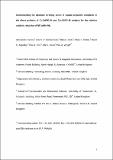Understanding the structure directing action of copper-polyamine complexes in the direct synthesis of Cu-SAPO-34 and Cu-SAPO-18 catalysts for the selective catalytic reduction of NO with NH3
Abstract
Cu2+ cations complexed by linear polyamines have been studied as structure-directing agents (SDAs) for the direct synthesis of copper-containing microporous silicoaluminophosphate (SAPO) materials. The complexing ligands diethylenetriamine (DETA), N-(2-hydroxyethyl)ethylenediamine (HEEDA), triethylenetetramine (TETA), N,N′-bis(2-aminoethyl)-1,3-propanediamine (232), 1,2-bis(3-aminopropylamino)ethane (323), tetraethylenepentamine (TEPA) and pentaethylenehexamine (PEHA) have been investigated. For comparison, syntheses have been performed using the analogous nickel-polyamine complexes. Cu2+ and Ni2+ forms of both SAPO-18 and SAPO-34 materials have been prepared. While most polyamine complexes direct crystallisation to SAPO-34, SAPO-18 has been prepared with Cu2+(232), Ni2+(232) and Ni2+(TETA). The coordination geometry of the included metal complexes was studied by UV-visible and EPR spectroscopy and computer simulation. SAPO-18 is favoured by the smaller square planar complexes or octahedral species (with 2 water molecules) of 232 and TETA. Calcination leaves extra-framework Cu2+ and Ni2+ cations within SAPO-18 and SAPO-34 frameworks. In situ synchrotron IR spectroscopy of Ni-SAPO-18 has shown thermal template degradation occurs via nitrile intermediates. Rietveld structural analysis located extra-framework Cu2+ and Ni2+ cations released by calcination. In SAPO-34, Cu2+ and Ni2+ were located in the 8R window of the cha cage. A second site was found for Ni2+ at the centre of the six-membered rings (6Rs) of the double-six-ring (D6R) sub-units. In SAPO-18 both Cu2+ and Ni2+ cations were located only in the 6Rs of the D6R sub-units. Selected copper SAPO-18 and SAPO-34 samples were tested in the selective catalytic reduction of NO with ammonia (NH3-SCR); both showed high activity.
Citation
Turrina , A , Eschenroeder , E C V , Bode , B E , Collier , J E , Apperley , D C , Cox , P A , Casci , J L & Wright , P A 2015 , ' Understanding the structure directing action of copper-polyamine complexes in the direct synthesis of Cu-SAPO-34 and Cu-SAPO-18 catalysts for the selective catalytic reduction of NO with NH 3 ' , Microporous and Mesoporous Materials , vol. 215 , pp. 154-167 . https://doi.org/10.1016/j.micromeso.2015.05.038
Publication
Microporous and Mesoporous Materials
Status
Peer reviewed
ISSN
1387-1811Type
Journal article
Description
This work has been supported by Johnson Matthey PLC, UK.Collections
Items in the St Andrews Research Repository are protected by copyright, with all rights reserved, unless otherwise indicated.

